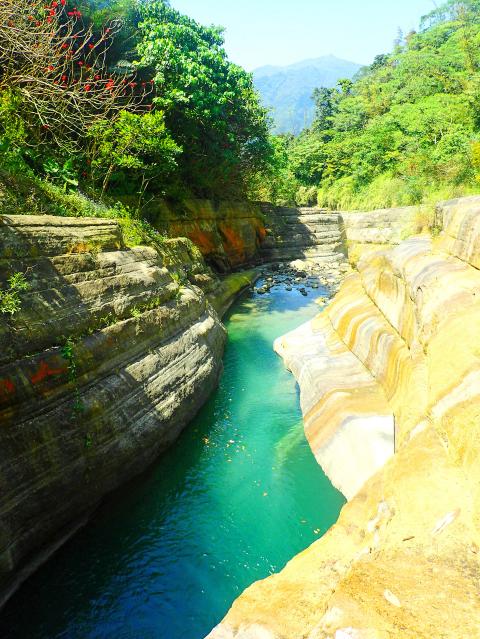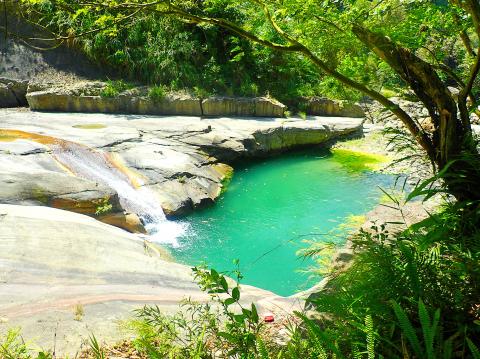Most people would probably agree that Taroko Gorge is Taiwan’s greatest tourist attraction, yet as I contemplate yet another visit (it’s naturally one of the essential elements of any tour when friends or relatives come), I’m likely to moan a little.
Anticipating convoys of tour buses, the lack of any really good permit-free hikes in the gorge, and an atrocious jabsence of edible food among the stalls at Tiansiang (天祥) doesn’t have me itching to return.
However, once there, and passing, awestruck, through its narrowest, most spectacular sections, goggling up at the towering walls hemmed in so close together, it’s hard to disagree that this is the most incredible thing most visitors to Taiwan will ever see.

Photo: Richard Saunders
GORGES, GORGES EVERYWHERE
Taiwan actually boasts other gorges and canyons that, in their way, are almost equally spectacular. Nantou County’s legendary but presently inaccessible Taiji Canyon (太極峽谷) springs immediately to mind, and some of the great chasms cut by countless streams and rivers in the remote central highlands are truly spectacular, yet have been barely explored.
However, size isn’t the only consideration, and no place in Taiwan fits the adage that small is beautiful better than Wannian Gorge (萬年峽谷) in central-southern Yunlin County. For several hundred meters a large mountain stream here has cut into an expanse of flat bedrock to create a small but stunning gorge.

Photo: Richard Saunders
The stream plunges over a series of little waterfalls and waterslides and through a chain of deep pools before finally plummeting over the much bigger drop of Dragon Phoenix Waterfall (龍鳳瀑布) at the end. Above the gorge, the stream can be traced up to the foot of another lofty and rarely visited cascade, Tongxin Waterfall (同心瀑布).
Getting to either waterfall unfortunately requires river tracing skills, but for less ambitious visitors, Wannian Gorge itself (the name means “10,000 years,” although it was surely created over a much longer period of time) is certainly fascinating and beautiful enough to warrant the protracted journey out there.
It’s also suitable for all: the (unintentionally) amusing English translation that appears on some signs — “All Ages Canyon” — is (for once) appropriate, as the short walk on a surfaced path down to the gorge is within the range of most people.

Photo: Richard Saunders
Sadly, there’s a catch.
Freely accessible for decades, since late last year access has officially been limited to the viewing platform above the gorge. Following a series of drowning deaths in the gorge’s deep pools over the last couple of years, local authorities have recently clamped down hard, barricading (with an ugly expanse of metal sheeting) the trail that leads the last few meters across the rock to the edge of the gorge.
According to a report I’ve heard, guards are also stationed here on weekends to make sure no one tries to sneak through and get down to the gorge and pools, although the place was deserted on my midweek visit in late last month.
Getting to Wannian Gorge means a fairly lengthy trip along winding mountain roads whichever direction you approach from. The nearest big town, Jhushan Township (竹山) in Nantou County, is a 30km drive away. From Chiayi City, which is better for scooter and car hire, it’s nearly 50km.
Take County Road 149B (149乙), the road running south from Jhushan to the mountain resort of Caoling (草嶺), and the way to the gorge is clearly signposted (in English). The last 3.5km are along the now dead-end route County Road 149A (149甲). Immediately after passing through the third half-tunnel turn sharp left to reach a car park at the start of the short trail down to the gorge.
TRAILHEAD
The trailhead is marked by a huge, inscribed boulder beside the track, and a family of free-range chickens always seem to be scurrying around. On my first visit a decade ago, I was astonished, as I passed through, to see the birds weren’t pecking around on the ground, as chickens usually do, but were all perched high up in the branches of the small trees that grow on either side of the lane. Whether they’d somehow evolved a talent to get themselves up there, or had been placed up there by a cunning human in an effort to stop them from wandering off, is one of those uniquely Taiwan mysteries that will probably never be solved.
Leaving the car park and chickens, the lane narrows to a surfaced path that zigzags gently down the hillside towards the gorge. In just a couple of minutes the finest section of Wannian Gorge comes into view. Here the Neihu Stream (內湖溪) has cut a narrow slot 10 to 15 meters deep through the flat, bare bedrock, exposing many layers of strata and creating a series of deep pools linked with cascades. About halfway down, a large, elongated pool (reputedly 10 meters deep) has been dubbed the Treasure Island Pool (寶島池), a reference, of course, to Taiwan, due to its shape.
Some of the pools look perfect for a swim, especially those near the bottom of the series, where the stream emerges from its narrow slot and runs over the wide and flat, fossil-studded rock pavement, although swimming is no longer officially allowed.
Following the stream down for another 100 meters, the water begins cutting deep into the flat rock bed once more, before it makes a curious and very sudden 90-degree bend, and plummets off a sheer, 20-meter-high cliff in the spectacular Dragon Phoenix Waterfall (龍鳳瀑布).
Gingerly peering over the edge, only a glimpse of the torrent can be seen. To see the waterfall properly means another lengthy, slow drive along winding mountain roads to Jhanghu (章湖), and a 30-minute river trace.
Richard Saunders is a classical pianist and writer who has lived in Taiwan since 1993. He’s the founder of a local hiking group, Taipei Hikers, and is the author of six books about Taiwan, including Taiwan 101 and Taipei Escapes. Visit his Web site at www.taiwanoffthebeatentrack.com

This month the government ordered a one-year block of Xiaohongshu (小紅書) or Rednote, a Chinese social media platform with more than 3 million users in Taiwan. The government pointed to widespread fraud activity on the platform, along with cybersecurity failures. Officials said that they had reached out to the company and asked it to change. However, they received no response. The pro-China parties, the Chinese Nationalist Party (KMT) and Taiwan People’s Party (TPP), immediately swung into action, denouncing the ban as an attack on free speech. This “free speech” claim was then echoed by the People’s Republic of China (PRC),

Exceptions to the rule are sometimes revealing. For a brief few years, there was an emerging ideological split between the Democratic Progressive Party (DPP) and Chinese Nationalist Party (KMT) that appeared to be pushing the DPP in a direction that would be considered more liberal, and the KMT more conservative. In the previous column, “The KMT-DPP’s bureaucrat-led developmental state” (Dec. 11, page 12), we examined how Taiwan’s democratic system developed, and how both the two main parties largely accepted a similar consensus on how Taiwan should be run domestically and did not split along the left-right lines more familiar in

Most heroes are remembered for the battles they fought. Taiwan’s Black Bat Squadron is remembered for flying into Chinese airspace 838 times between 1953 and 1967, and for the 148 men whose sacrifice bought the intelligence that kept Taiwan secure. Two-thirds of the squadron died carrying out missions most people wouldn’t learn about for another 40 years. The squadron lost 15 aircraft and 148 crew members over those 14 years, making it the deadliest unit in Taiwan’s military history by casualty rate. They flew at night, often at low altitudes, straight into some of the most heavily defended airspace in Asia.

Many people in Taiwan first learned about universal basic income (UBI) — the idea that the government should provide regular, no-strings-attached payments to each citizen — in 2019. While seeking the Democratic nomination for the 2020 US presidential election, Andrew Yang, a politician of Taiwanese descent, said that, if elected, he’d institute a UBI of US$1,000 per month to “get the economic boot off of people’s throats, allowing them to lift their heads up, breathe, and get excited for the future.” His campaign petered out, but the concept of UBI hasn’t gone away. Throughout the industrialized world, there are fears that